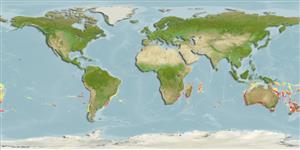>
Scombriformes (Mackerels) >
Trichiuridae (Cutlassfishes) > Aphanopodinae
Etymology: Benthodesmus: Greek, benthos = depth of the sea + Greek, desmos = bond, chain (Ref. 45335).
Environment: milieu / climate zone / depth range / distribution range
Ökologie
seewasser benthopelagisch; tiefenbereich 178 - 950 m (Ref. 6181). Deep-water; 9°S - 44°S, 30°E - 26°W (Ref. 6181)
Atlantic, Indian and Pacific: off south Brazil and Argentina, Rio Grande Rise, southeastern Africa, Madagascar Ridge, southeastern Australia, New Zealand, Sala y Gomez Ridge.
Length at first maturity / Size / Gewicht / Alter
Maturity: Lm ?, range 57 - ? cm
Max length : 100.0 cm TL Männchen/unbestimmt; (Ref. 9351)
Kurzbeschreibung
Morphologie | Morphometrie
Rückenflossenstacheln (insgesamt): 42 - 46; Rückenflossenweichstrahlen (insgesamt): 99-108; Afterflossenstacheln 2; Afterflossenweichstrahlen: 91 - 98; Wirbelzahl: 151 - 159. Body silvery, jaws and opercle blackish. The inside of the mouth and gill cavities black.
Juveniles mesopelagic (Ref. 6181); also benthopelagic (Ref. 5951). Feeds on crustaceans (mainly prawns and euphausiids), small fishes (e.g. Maurolicus) and squid (Ref. 6202). Minimum depth reported from Ref. 36453.
Life cycle and mating behavior
Geschlechtsreife | Fortpflanzung | Ablaichen | Eier | Fecundity | Larven
Batch spawners with 5,000 to 16,000 eggs per spawn.
Nakamura, I. and N.V. Parin, 1993. FAO Species Catalogue. Vol. 15. Snake mackerels and cutlassfishes of the world (families Gempylidae and Trichiuridae). An annotated and illustrated catalogue of the snake mackerels, snoeks, escolars, gemfishes, sackfishes, domine, oilfish, cutlassfishes,. scabbardfishes, hairtails, and frostfishes known to date. FAO Fish. Synop. 125(15):136 p. (Ref. 6181)
IUCN Rote Liste Status (Ref. 130435)
Bedrohung für Menschen
Harmless
Nutzung durch Menschen
Mehr Information
Alter/GrößeWachstumLänge-GewichtLänge-LängeLängenhäufigkeitenMorphometrieMorphologieLarvenLarven Pop.Dyn.RekrutierungDichteBRUVS
ReferenzenAquakulturAquakultur ProfilZuchtlinienGenetikElectrophoresesVererbbarkeitKrankheitenVerarbeitungNutrientsMass conversion
PartnerBilderStamps, Coins Misc.LauteCiguateraGeschwindigkeitSchwimmstilKiemenoberflächeOtolithsGehirngrößeSehfähigkeit
Tools
Zusatzinformationen
Download XML
Internet Quellen
Estimates based on models
Preferred temperature (Ref.
123201): 8.9 - 17.1, mean 11.7 °C (based on 175 cells).
Phylogenetic diversity index (Ref.
82804): PD
50 = 0.5005 [Uniqueness, from 0.5 = low to 2.0 = high].
Bayesian length-weight: a=0.00014 (0.00008 - 0.00025), b=3.10 (2.93 - 3.27), in cm total length, based on LWR estimates for this species & (Sub)family-body (Ref.
93245).
Trophic level (Ref.
69278): 3.9 ±0.66 se; based on food items.
Widerstandsfähigkeit (Ref.
120179): niedrig, Verdopplung der Population dauert 4,5 - 14 Jahre. (tm=5-6).
Fishing Vulnerability (Ref.
59153): High vulnerability (60 of 100).
Nutrients (Ref.
124155): Calcium = 14.8 [6.8, 30.5] mg/100g; Iron = 0.302 [0.138, 0.677] mg/100g; Protein = 16.7 [15.0, 18.3] %; Omega3 = 0.232 [0.105, 0.515] g/100g; Selenium = 27.2 [10.9, 72.9] μg/100g; VitaminA = 15.2 [2.6, 81.5] μg/100g; Zinc = 0.362 [0.223, 0.599] mg/100g (wet weight);
